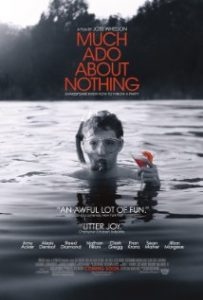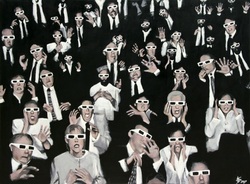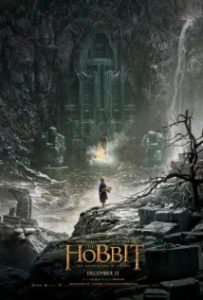 Joss Whedon has this weird way of going about making movies and TV shows. On the one hand, he’s known in the big networks and studios for success stories like Buffy the Vampire Slayer and last summer’s The Avengers (or “shows that shouldn’t have been canceled so soon” like Firefly that can make some fans perennially sigh over what might have been if the show had kept going). But on the other hand, he does stuff like… make some kind of movie broken into two parts during a writer’s strike (Dr. Horrible’s Sing-Along Blog, a strange but endearing mixture of superheroes with musical, drama, romance, and tragedy). More, he can make this kind of thing work, as that odd, two-part movie grew into an internet sensation that’s followed as much as anything made by a major network.
Joss Whedon has this weird way of going about making movies and TV shows. On the one hand, he’s known in the big networks and studios for success stories like Buffy the Vampire Slayer and last summer’s The Avengers (or “shows that shouldn’t have been canceled so soon” like Firefly that can make some fans perennially sigh over what might have been if the show had kept going). But on the other hand, he does stuff like… make some kind of movie broken into two parts during a writer’s strike (Dr. Horrible’s Sing-Along Blog, a strange but endearing mixture of superheroes with musical, drama, romance, and tragedy). More, he can make this kind of thing work, as that odd, two-part movie grew into an internet sensation that’s followed as much as anything made by a major network.
And now he’s made a production of Much Ado About Nothing. Apparently Whedon has an amazing house and regularly invites actors and actresses to come out and perform a Shakespeare play. Why not? I probably would too, if I had a fabulous house and was a director. To add to the fun, this time around he’s made a film out of this practice. He chose a fine play to do this with, as Much Ado is one of Shakespeare’s best comedies (for the uninitiated, a Shakespeare comedy means there’s going to be lots of fun, humor, and romance, but… there’s going to be a fair amount of heartache as well: the travails of Jimmy Stewart in It’s a Wonderful Life have nothing on what Shakespeare will put his comedic characters through).
I’ll be up front and say that Joss Whedon had to win me over with this one. I like a lot of his work and it sounded like this adaptation was pretty good, but… I love Kenneth Branagh’s 1993 adaptation of this play: it’s what won me over to Shakespeare at a young age. Sure, it’s got some weird moments and Keanu Reeves… cannot do Shakespeare to save his life, but it is otherwise excellent. Kenneth Branagh and Emma Thompson are razor sharp witty in their roles as the two lovebirds that refuse to believe they are lovebirds, and they are excellently juxtaposed against the two lovebirds that very much know they are lovebirds, played by Robert Sean Leonard and Kate Beckinsale. To cap things off, Michael Keaton is hilarious as the hapless constable, Dogberry.
So I’ll admit I didn’t completely click with some elements of the movie. Alexis Denisof and Amy Acker were good fun as Beatrice and Benedick, but… they just couldn’t speak it and act it like Branagh and Thompson did, particularly early on (though let’s face it, those two are heavyweights in the acting world). Still, they began to spark more for me as the other characters in the story try to draw them together. The closely paired scenes where Benedick and Beatrice learn that the other loves them (or so they are led to believe as they eavesdrop on their friends…) are as entertaining as I’ve seen in any production. Benedick’s sudden attempts to look sexy for Beatrice are as amusing to watch as junior highers at a school dance (so much awkwardness rolled up in so much sincerity). The pair isn’t all humor, either: Whedon closes the movie with a shot focusing solely on them, an indescribably romantic moment.
That said, the standouts among the actors are undoubtedly Nathan Fillion and Tom Lenk as the constable Dogberry and his assistant, Valence. In Kenneth Branagh’s adaptation, Michael Keaton plays Dogberry hilariously over the top with growls and mannerisms reminiscent of his role as Beetlejuice. Nathan Fillion, on the other hand, is openly and honestly sincere in his ineptitude (though he still manages to save the day, of course). Both performances are completely varied but completely hilarious. It highlights the strength of any good play–and book for that matter–the stories and characters can be great no matter how many times you revisit them.
But what seals the deal is the cinematography and the music. Whedon went from directing a superhero summer Hollywood blockbuster–with all the big action shots that implies–to using steady, fixed shots and vivid black and white cinematography in this film. There’s some versatile directing for you. Of course, he’s filming a location he knows quite well–his own gorgeous house with a spectacular view–but he uses that knowledge to maximum effect. Joss also enlisted the aid of his brother, Jed, and his wife Maurissa Tauncharoen, to perform a couple of the songs from the play (this duo were responsible for the catchy tunes in Dr. Horrible’s Sing-Along Blog). Both songs are a clean and engaging fit with the modern setting Whedon chose for the play, and I wish a movie from earlier this summer, The Great Gatsby, had done so well with matching its music to its story.
In the end, there are things not to like in Whedon’s production of Much Ado, but this is no different from any other Shakespeare production I’ve seen (or heard commented on). For theatrical afficianados, every new production of a play can offer new delights and interpretations–even small, classroom productions–and this is a good thing in the end. Even better, Whedon’s production offers many new things to delight in.

 They’re everywhere. They’re in commercials and they’re all over the internet. They keep the movie you’re about to watch from starting for 15-20 minutes (unless you’re smart and show up 15-20 minutes late, like a certain Viking and Celt enjoy doing). And sometimes, previews do what they’re supposed to do, getting you excited about an upcoming movie. Frequently, though, you can wonder who put the darn thing together.
They’re everywhere. They’re in commercials and they’re all over the internet. They keep the movie you’re about to watch from starting for 15-20 minutes (unless you’re smart and show up 15-20 minutes late, like a certain Viking and Celt enjoy doing). And sometimes, previews do what they’re supposed to do, getting you excited about an upcoming movie. Frequently, though, you can wonder who put the darn thing together. Okay, so… I got a little excited two weeks ago when the Celt found a preview for
Okay, so… I got a little excited two weeks ago when the Celt found a preview for  JRR Tolkien is one of my favorite authors. The Lord of the Rings is full of the stuff of life: themes and values worth thinking about, running right along great characters and a fantastic story. The Hobbit is also great fun in a more lighthearted way, with a delightful focus on how Bilbo grows and changes over his journey.
JRR Tolkien is one of my favorite authors. The Lord of the Rings is full of the stuff of life: themes and values worth thinking about, running right along great characters and a fantastic story. The Hobbit is also great fun in a more lighthearted way, with a delightful focus on how Bilbo grows and changes over his journey. Star Trek Into Darkness
Star Trek Into Darkness s it necessary to do a spoiler-free review of a movie based on a book that’s almost a century old? Probably not, but there’s inevitably someone out there complaining when someone spoils the end of The Empire Strikes Back (okay, that was me–I couldn’t believe someone had “ruined it” for The Celt. She hadn’t seen the movie, so how could she know who Luke’s father was? Darn spoilery people types…).
s it necessary to do a spoiler-free review of a movie based on a book that’s almost a century old? Probably not, but there’s inevitably someone out there complaining when someone spoils the end of The Empire Strikes Back (okay, that was me–I couldn’t believe someone had “ruined it” for The Celt. She hadn’t seen the movie, so how could she know who Luke’s father was? Darn spoilery people types…).